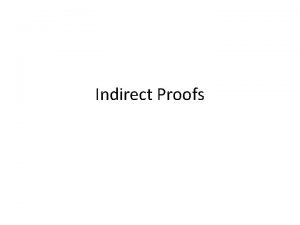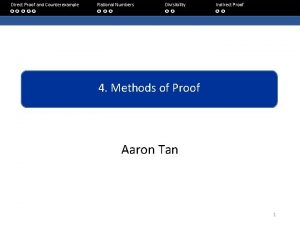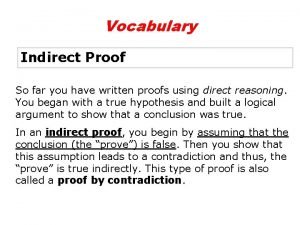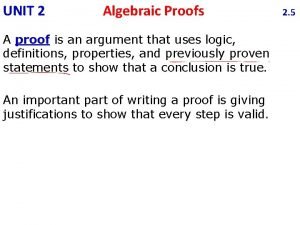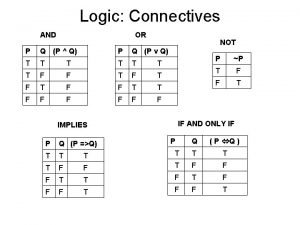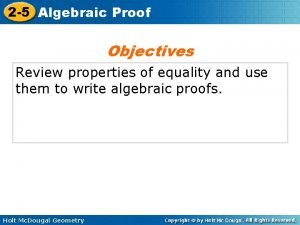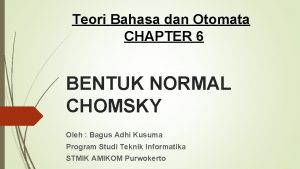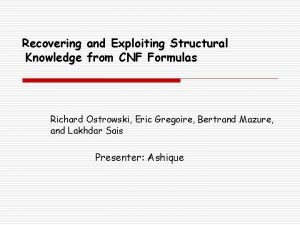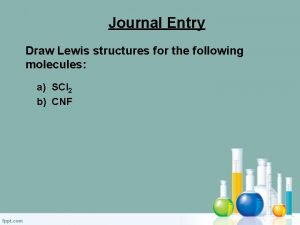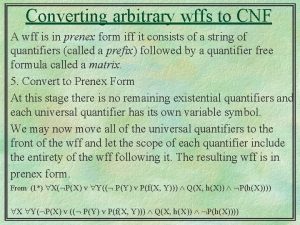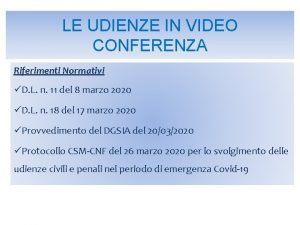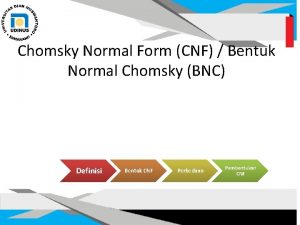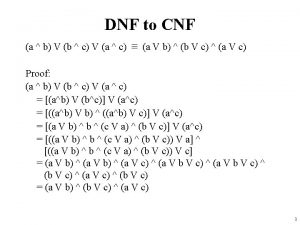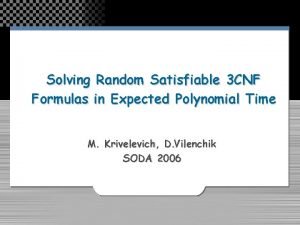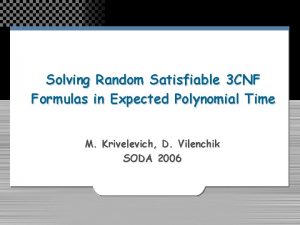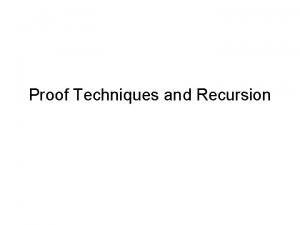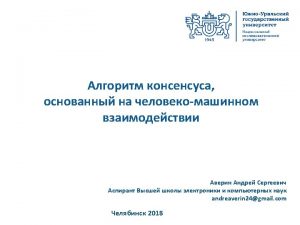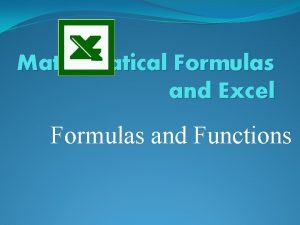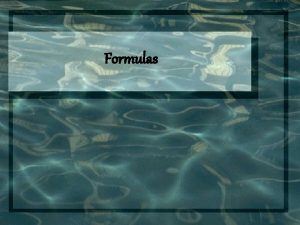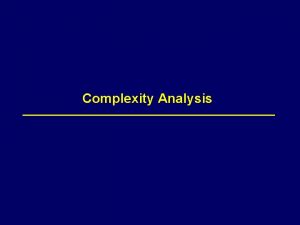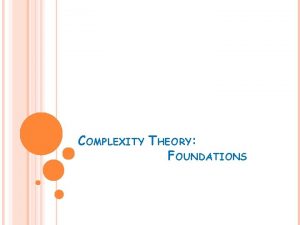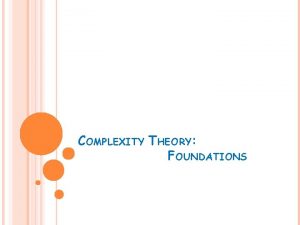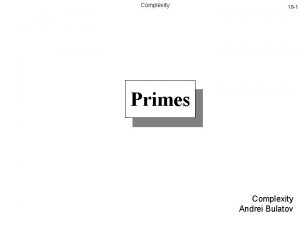PROOF COMPLEXITY OF DENSE RANDOM 3 CNF FORMULAS





















- Slides: 21

PROOF COMPLEXITY OF DENSE RANDOM 3 CNF FORMULAS Based on joint work with Sebastian Müller (Prague) Iddo Tzameret Institute for Theoretical Computer Science, IIIS Tsinghua university, Beijing 1

! e c n e t n e s In ONE We give an (optimal? ) propositional characterization of the currently best known 3 CNF unsatisfiability witnesses.

! s e c n e t n e s O W T In • We prove the correctness of the Feige, Kim, Ofek (FOCS 2006) unsatisfiability witnesses of random 3 CNF formulas with cn 1. 4 clauses within TC 0 -Frege system. • We use such proofs to obtain propositional refutations of random 3 CNF formulas with cn 1. 4 clauses.

Background & Overview

Abstract Proof Systems • Propositional proof system: a polytime verifier A(x, y) for proofs x of tautologies y (sound and complete). • The proof x can be of any kind. • But most work in proof complexity is dedicated to understanding concrete proofs---within the Frege hierarchy.

Concrete Proof Systems: the Frege Hierarchy Frege proof systems: • • • Frege = NC 1 -Frege Extended Frege = P/poly-Frege Bounded-depth Frege = AC 0 -Frege

Concrete Proof Systems: the Frege Hierarchy TC 0 -Frege: • Unbounded fan-in formulas with threshold gates Thi(x 1, …, xm), for any i, m Thi(x 1, …, xm)=1 iff at least i of xj’s are true. TC 0 -Frege rules like: • A TC 0 -Frege proof of a family {fi : i>0}: a family of TC 0 -Frege proofs with a constant bound on depth of all formulas in proofs.

“Average Case” Proof Complexity • A popular “average case” model of unsatisfiable formulas: Random k. CNF. • Random 3 CNF’s: • Fix n number of variables x 1, . . . , xn, and m(n) number of 3 clauses; • Choose independently (with repetitions) m 3 -clauses out of all possible 3 -clauses over n variables. • Over the threshold m~4. 6 n it’s known that 1 -o(1) of all 3 CNFs are unsatisfiable. • “Average case” proof complexity: • Do we have short P-refutations for random 3 CNFs?

“Average Case” Proof Complexity • Chvatal & Szemeredy `88, Ben-Sasson & Wigderson `01, Beame, Karp, Pitassi & Saks `02: for most 3 CNFs with cn 1. 5 -e number of clauses (for 0<e), no sub-exponential resolution refutations. • Strongest proof system with random 3 CNF 0 -Frege OUR RESULT : Polynomial-size TC lower bounds (AFAIK): Res(log/log n). refutations for random 3 CNF formulas • Average case Upper bounds? Only for with atm≥cn least 2/logn cn 1. 4 clauses(Beame et al. ) in resolution.

Refutation algorithms Spectral approach initiated by Goerdt & Krivelevich (STACS 2001), and led to Feige, Kim and Ofek (FOCS 2006): Algorithm A(K) • Input: 3 CNF K Idea of method: • • Random Output: 3 CNF “K isinduces unsatisfiable” or “Don’t know”. an associated random graph. is never wrong. • A One can verify efficiently that a random graph does • not With 1 -o(1) over 3 CNFs K, haveprobability a large cut with high probability by. A(K) answers “Kthe is unsatisfiable ”, inassociated polynomial-time. considering spectrum of the matrix (e. g. , the adgacency matrix).

Refutation algorithms Example in our case (exsercise): • M is an nxn symmetric rational matrix defined as follows: • Start from M=0 Largest • For every clause C in the 3 CNF: eigenvalue of • Add ½ to Mij if xi, xj are in C and have different M polarities • Add -½ to Mij if xi, xj are in C and have same polarities n , any clause C • Corollary: Then: Let fork =any assignment a in {-1, 1} #clauses satisfied as NAE by a. Then: adds to the value of at. Ma +1 so if C’s literals are Not All Equal (NAE) under a, and otherwise C adds -3 to this value.

Refutation algorithms • Feige, Kim & Ofek (FOCS 2006): nondeterministic refutation algorithm for 3 CNFs with at least cn 1. 4 clauses (i. e. , witnesses). • We “simulate” this construction inside a weak propositional proof system Corollaries & motivations of our result: 1. All known refutation algorithms are not stronger than TC 0 Frege. 2. Separates TC 0 -Frege from resolution in random 3 CNF regime 3. Technical contribution: carry out certain spectral arguments inside weak propositional proof systems. 4. Conjecture: ~depth-2 -Frege admits quasi-polynomial refutations for random 3 CNFs with ≥ cn 1. 4 clauses.

Proof Overview

Proof overview Goal: Construct certain propositional proofs in TC 0 -Frege • For simplicity: work in the first order theory VTC 0 [CN’ 10] • Exists first-order proof Exists polysize propositional proof

Proof structure Consider the first-order statement: (1) (FKO witness =the Feige et al. witness of unsatisfiability. ) • Prove (1) in a theory VTC 0 (that corresponds to TC 0 -Frege) • We get a poly-size TC 0 -Frege of the propositional translation of (1), denoted (1’)

Proof structure (1’) • Let C be a random 3 CNF with cn 1. 4 clauses. By Feige et al. almost surely it has an FKO witness w • The premise of (1’) is satisfied by C, w Lemma: Assigning ”C” to consequence in (1’) yields ¬C Thus, we get φ ¬C , for φ a tautological sentence (no variables) of polynomial-size. And we’re done.

Proof structure Bulk of work: prove the implication in VTC 0! The main formula (1) looks like: (where all free variables are universally quantified).

Zoom in: spectral argument in TC 0 -Frege Because the • We need to prove in theory: premise conclusion form of the main formula, when plugging-in for any a in {-1, 1}: t the actual CNF with its • The proofs goes via writing a as a linear values of M, λ, corresponding etc. , the premise becomes true combination of M’s eigenvectors. (i. e. , disappears). a Ma≤ λn. TWO OSTENSIBLE OBSTACLES: 1. Eigenvalues and eigenvectors are reals. Don’t have reals in our theories. Fortunately: 2. Proving the statement of linear algebra conjectured to be 1. Enough to use rational approximations 0 beyond TC -Frege. (E. g. , apparently can’t prove (in theory) that for 2. In our application enough to state following implication: any matrix M exists an object λ, which has the properties of an eigenvalue -1 are objects that have the Assuming λ , …, λ , and V, V 1 n of M. ) properties of being eigenvalues and eigenvectors matrix and its inverse, respectively, then for any a in {-1, 1}: at. Ma≤ λn

Zoom in: spectral argument in TC 0 -Frege Lemma: TC 0 -Frege proves that for any {-1, 1}n vector a, if M is a real symetric nxn matrix, ={ } the eigenvalues of M, and V nxn matrix whose rows are the eigenvectors of M, then Because of rational approximations So, one can prove in theory that: for vi's the approximate eigenvectors of M and some rationals 's. • Now simulate standard proof to obtain the spectral inequality (a lot of computations due to approximations).

Conclusions • All refutation algorithms fits into TC 0 -Frege from proofcomplexity perspective • Can we make the upper bound tighter? • Can we extract an algorithm?

Thank You!
 The earth's layers foldable
The earth's layers foldable Which layer is the least dense
Which layer is the least dense The layers of earth from most dense to least dense
The layers of earth from most dense to least dense Time space complexity
Time space complexity Steps in writing indirect proof
Steps in writing indirect proof Direct proof and indirect proof
Direct proof and indirect proof Indirect proof assumption
Indirect proof assumption Unit 2 logic and proof homework 1
Unit 2 logic and proof homework 1 Direct proof and indirect proof
Direct proof and indirect proof 2-5 algebraic proof
2-5 algebraic proof Cnf automata
Cnf automata Cnf lewis structure
Cnf lewis structure Nocl bond angle
Nocl bond angle Wff to cnf
Wff to cnf Pnf vnf cnf
Pnf vnf cnf Fob and cnf
Fob and cnf Note di trattazione scritta modello cnf
Note di trattazione scritta modello cnf Cnf korea
Cnf korea Chomsky normal form
Chomsky normal form Cnf vs dnf
Cnf vs dnf Random assignment vs random selection
Random assignment vs random selection Random assignment vs random sampling
Random assignment vs random sampling




